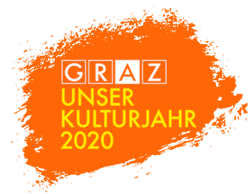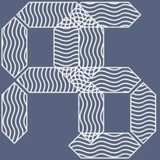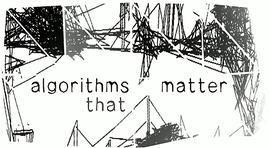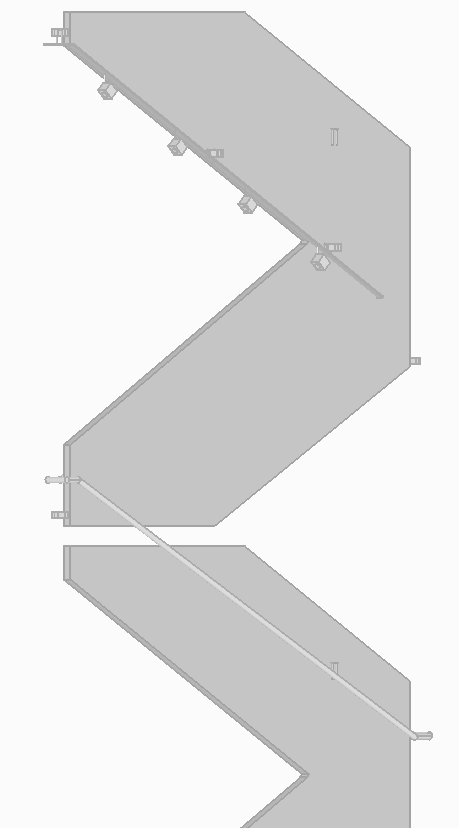Through Segments is a sound installation in an unusual interstitial space—the staircase of the Kunsthaus’ Iron House that connects to the “Friendly Alien”. Four artists listen into the storeys using real-time computer algorithms, taking an acoustical image of the visitors’ movements, forming four individual reactions. It is a poetic attempt to think about the distributed, the fragmented, the parallel. During the development phase, the artists work independently, but at the same time they observe and interrogate each other, performing the gesture of a “simultaneous arrival” (Sara Ahmed). They enact a human algorithm, informed by reiteration and duplication but never being identical. The aim is not one “of all converging towards the same, but circulating, making common relaying, relaying back, being relayed” (Isabelle Stengers).
{function: contextual, origin: program notes}
A project within “Algorithmic Segments” in collaboration with Kunsthaus Graz, and Algorithms that Matter (ALMAT). Co-funded by the City of Graz in the framework of Graz Kulturjahr 2020.
{function: contextual}
[de]
Durchlässige Segmente
Eine Klangkunstausstellung für das Stiegenhaus des Kunsthauses Graz, 2020.
{kind: title}
Durchlässige Segmente ist eine Klanginstallation an einem ungewöhnlichen Zwischenort—der Stiege des Eisernes Hauses des Kunsthauses, das an den „freundlichen Außerirdischen“ andockt. Vier Künstler*innen horchen mittels Echtzeit-Computeralgorithmen in die Stockwerke hinein, machen sich ein akustisches Bild von den Bewegungen der Besucher*innen und reagieren jeweils auf eigene Weise darauf. Es ist ein poetischer Versuch, über das Verteilte, Fragmentierte und Parallele nachzudenken, indem die Künstler*innen während der Entstehungsphase einerseits unabhängig voneinander arbeiten, sich aber gegenseitig beobachten und befragen und die Geste einer „simultanen Ankunft“ (Sara Ahmed) ausführen. Sie vollziehen einen menschlichen Algorithmus, der von Wiederholungen und Verdopplungen aber nie Identischem geprägt ist. Ziel ist nicht, dass „alles zum gleichen zusammenläuft, sondern ein Zirkulieren, ein gemeinsames Relais bilden, etwas Zurückgeben, Weitergegeben werden“ (Isabelle Stengers).
{function: contextual, origin: program notes}
Ein Projekt im Rahmen von „Algorithmische Segmente“ in Kollaboration mit dem Kunsthaus Graz und Algorithms that Matter (ALMAT). Kofinanziert durch die Stadt Graz im Rahmen des Graz Kulturjahres 2020.
Exhibition in the framework of Algorithmic Segments
| Artist Talk: | 05.09.2020, 11:00 h |
| Exhibition: | 05.09.–04.10. (Tue–Sun 10–17 h) |
| Location: | Kunsthaus Graz, Lendkai 1, 8020 Graz |
In this exposition Ji Youn Kang (jyk), David Pirro (dp), Daniele Pozzi (poz) and Hanns Holger Rutz (hhr) document the development of their collaborative, site-specific sound installation for the Graz Kunsthaus staircase. The four individual, but interconnected, real-time algorithms make use of speakers and microphones to interact with the space and its visitors.
The idea of the parallel and the segmented is also transposed in their working method, that allows to proceed independently, but at the same time observing and interrogating each other in regular discussion rounds in which they share ideas, developments and results, through reiterated gestures of confrontation, perturbation, speculation and (re)adaptation distributed over several months. One can navigate this process following the development timeline on the right. Each single page is a condensation of a single step of the simultaneous activity performed over time.
{function: contextual}
The piece is embedded in the parcours Algorithmic Segments. The artistic research process and discussion and development around the piece is embedded in the project Algorithms that Matter; some additional materials can thus be found in ALMAT Iteration 5. It is also a test case for a forthcoming research project on artistic collaboration.
{function: contextual}
---
meta: true
author: [HHR, DP, JYK, POZ]
date: 2020
artwork: ThroughSegments
project: AlgorithmicSegments
place: Kunsthaus
function: Overview
keywords: [sound installation, simultaneous arrivals, algorithm, reiteration, relaying, space, sound, listening]
---
Our original idea was to select a specific algorithm, or a class of algorithms, that could function as a common basis for the sound installation. Each of us four would then declinate the algorithm according to their own practice, formulating an idiosyncratic implementation that could let emerge different, fragmented affordances of the algorithmic and make them aurally perceivable. Between October and December 2019 we had several sessions in which we attempted to find the algorithm.
An early page dedicated to brainstorming, in which we were looking for algorithmic dispositions we might have an interest in to work with.
Hanns Holger's proposal: simultaneous arrivals. This is the final proposal we chose, and a fundamental aspect of this is that we abandoned the idea of working with a common algorithm. This new approach is centered around a disposition based on “discussion rounds” taking place at first on the RC and then through physical or virtual meetings. During these rounds we ask, and respond to, different questions related to the Kunsthaus piece, interrogating each other, sharing ideas, observing and (re)adapting.
In December 2019 we had our first round of questions. These four pages contain questions or statements that each of us thought would be useful for the development of the piece and to start a discussion with the others.
We agreed on having a second round of “responses”, in which each of us would try to integrate and draw connections between responses received in the previous round.






















